Recipes
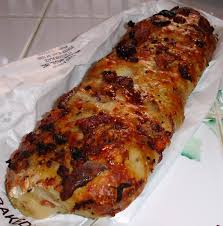
Proscuitto Bread
Straight dough method (mixed fermentation) Mix the water, yeast, flour, salt, and fat 6 minutes at first speed. Add Basic Yeast Starter and mix another 4 minutes. Add the prosciutto and mix another 1–2 minutes. Fermentation 1 hour at 27°C shape Scale at 360–540 g or as desired. Shape like long Italian loaves. . Baking 220°C with steam
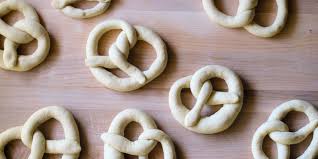
Pretzel Dough
Straight paste method SHAPING Scaling: With a bench scraper, cut a long piece of dough weighing 150g. With the palms of your hands, roll on the bench until you reach a uniform band 75 cm long. Twist in a pretzel shape. Soak in a solution of 60 g sodium bicarbonate in 500 ml of water. Arrange on baking sheets lined with parchment. Stretch and reform pretzel shapes as needed. (Note: After soaking in soda solution, the units are difficult to handle. If desired, first cook the pretzels, then brush thoroughly with the soda solution.) Sprinkle with pretzel salt. Bake at 260°C for 8 to 9 minutes or until golden brown. Optional: Dip the melted butter immediately after cooking and drain.
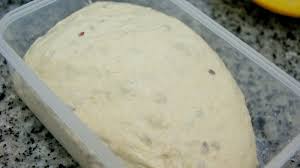
Fermented Dough
Disperse the yeast in the water, add the flour and salt, and mix until just smooth. At 60 percent hydration, it will be stiff and dense, but add water, if necessary, to correct the hydration. Cover the bowl with plastic and let stand for 12 to 16 hours at about 18℃. When ripe, the pre-ferment will be domed and just beginning to recede in the center.
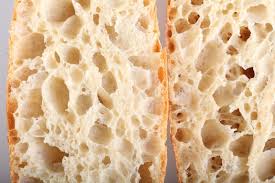
Poolish Baguette
to make the poolish: Combine the flour, water, and yeast. Cover the container and allow to rest for 12 to 16 hours at room temperature. When the poolish is ready to use, it will be doubled in size, and filled with large bubbles. To make the dough: Add the water to the poolish. Add the flour, mix to combine, cover the bowl, and allow the mixture to rest for 20 minutes. This rest period (autolyse, in French) allows the flour to absorb the liquid and the gluten to start its development, making kneading easier and more effective. Add the yeast and salt, and knead the dough until it's fairly smooth, about 5 to 7 minutes by hand, 3 to 4 minutes by electric mixer, or 5 to 7 minutes in a bread machine. The gluten will continue to develop as the dough rises, so you don't want to develop it fully during the kneading process. Place the dough in a lightly greased bowl, cover the bowl, and allow the dough to rise, at room temperature, for 1 1/2 hours. To help develop the gluten, distribute the yeast's food, and expel any excess carbon dioxide, turn the dough every 30 minutes during the rising time: gently fold all four sides into the middle, and turn the dough over. Transfer the dough to a lightly greased work surface, divide it in half, shape each half into a rough log, cover them, and let them rest for 15 to 20 minutes. This allows the gluten to relax, making it easier to shape the bread.
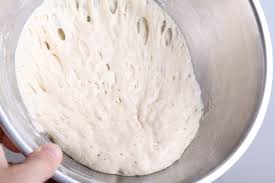
Poolish
Prepare the poolish the night before baking. Combine the bread flour, water, and yeast and mix until smooth. Cover the bowl with plastic wrap and let stand at room temperature 20°C to 21°C for 12 to 16 hours overnight.
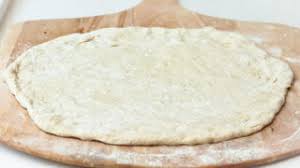
Pizza Dough
Using a 5 liter or larger stand mixer with a dough hook attachment, place the bread flour, water, instant yeast, salt, cornmeal, and poolish in the bowl and mix on low speed for approximately 4 1⁄2 minutes. After the ingredients have been incorporated, increase the mixing speed to medium and mix for 2 to 3 minutes, slowly adding the savory oil to the dough. shape 100-150 gr loave and keep resting for 24 hour before using bake a 300℃ with all the topping in a pizza oven for 3-4 mn

Pita Bread
Straight dough method Fermentation Until doubled in bulk, about 11⁄2 hours at 27°C Makeup and Baking Scale at 90 g. Round the units and bench-rest. With a rolling pin, roll out into circles about 10–12 cm in diameter. Bake on oven hearth or on dry sheet pans at 260°C until lightly golden around edges, about 5 minutes. Do not overbake, or the pitas will be dry and stiff.
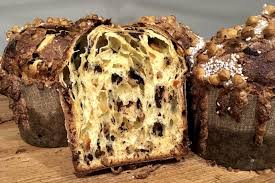
Panettone
Mixing and fermentation. Prepare the marinated fruit mixture: Combine the raisins, peel, almonds, zest, juice, rum and nutmeg in a bowl. Cover and marinate for several hours or, refrigerated, overnight. Sift the flour into a bowl and make a well in the center. Heat the milk to 37°C and mix with the yeast. Pour this mixture into the well in the flour. Sprinkle some flour from the sides of the bowl over the liquid yeast. Cover the bowl and let stand room temperature until the flour begins to appear cracked on top and the mixture bubbles, about 45 minutes. 4. Add the egg yolks, salt and sugar flour mixture. Mix slightly to form a soft dough. Turn off on a floured work surface and knead for 10 minutes until smooth. Place the dough in a lightly floured bowl, cover with a damp cloth and let it ferment at room temperature until doubling in size. Drain the marinated fruits. Add the fruit and butter, softened, into the dough until smooth and well incorporated. Put back in the bowl and ferment a second time at room temperature until doubling in size
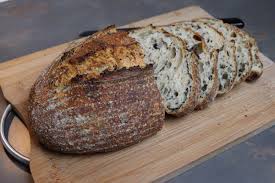
Onion Seed Sourdough
Combine all the dough ingredients in the bowl of a stand mixer and knead with the dough hook for 4 minutes. Add the flavourings, increase the speed to medium, and mix for 10 minutes more. Remove the bowl from the mixer, cover with a clean, damp tea towel, and leave to rise for an hour. Use your fists to punch out excess air, then turn onto a floured surface. Halve the dough and form each portion into a bloomer loaf (see here for how to form a bloomer). Line a baking sheet with baking paper and dust with flour. Transfer the loaves onto it, then put inside a large plastic bag, inflated so that it won’t come into contact with the dough. Place in the fridge and leave to prove for 8–10 hours, or overnight. “When proved, place the loaves still wrapped on the worktop to come up to room temperature (around 20°C). Depending on how hot your kitchen is, this could take an hour, or more. Once at room temperature check on them every 30 minutes until they have has doubled in bulk. Poke the dough with your finger: it should feel like a slightly deflated balloon, with plenty of air still inside it but not on the verge of popping. Watch after you poke it: it should spring back easily. Place a baking stone or baking sheet on the middle shelf and preheat the oven to its highest setting. Place a small baking tin on the oven floor to act as a water vessel. To finish the loaves, brush with water and dust thickly with extra flour. Cut a slash about 1cm deep down the length of each one. To bake, carefully pull the oven rack with the hot baking sheet or stone halfway out of the oven. Working quickly slide the loaves onto the hot surface, and push the rack back into the oven. Tip the ice cubes into the tin at the bottom of the oven and close the oven as swiftly as possible. After 10 minutes, reduce the heat to 200°C for a further 30 minutes. When the bread is baked, turn off the oven, open the door slightly and leave the bread for 5 minutes to let off some steam. Transfer to a wire rack to cool for at least an hour before you devour it.”
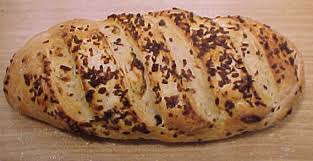
Onion Rye Bread
straight dough method: add all the ingredient in a dough mixer with cold water. mix 5 mn in a 1st speed and 8 mn 2nd speed. let rest 30 mn. cut 450gr dough and shape into a round ball. keep rest again for 30-45 mn and shape to desirate form. bake a 220 mn in deck oven foe 30mn
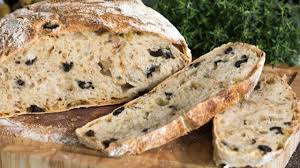
Olive Bread
Mix all the flours and water and mix just until they are combined. Let stand for 30 minutes (autolysis). Add starter and salt. Mix on low speed 5-8 minutes to develop the dough. Fermentation at 24 ° C until almost double in bulk, about 8 hours. baked in the oven on the ground 20 mn at 220 ℃
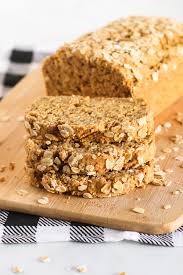
Oatmeal Bread
mixing: Place the oats in the mixing bowl. Add the water and turn the machine on for a moment to wet all the oats. Let stand for 15 or 20 minutes to soften. Add all the remaining ingredients to the bowl. In a spiral mixer, mix on first speed for 3 minutes in order to incorporate the ingredients thoroughly. The dough consistency should be moderately loose, with a slight tackiness from the honey. Turn the mixer to second speed and mix for 3 to 3 1⁄2 minutes, until a moderate gluten development has been achieved. Desired dough temperature: 24℃ Bulfermentation 2 hours (or overnight retarding). folding Fold the dough once, after 1 hour. dividing and Shaping: If the dough is going to be shaped into pan loaves, the dimensions of the pan will determine the dough weight. For a loaf pan measuring 10cm and about 22cm of dough will make a good fit and will take 900gr of dough. Freestanding loaves that will be baked directly on the hearth or baking stone can be divided into any weight. Tasty rolls of about 3 ounces each can also be made with the dough. Divide into desired weights and preshape the dough lightly into rounds. Place the dough pieces on a lightly floured
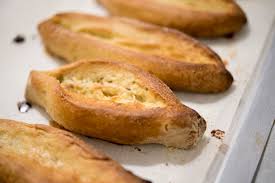
Navette Bread
In a large bowl mix the sugar and softened butter. Stir until you get a homogeneous yellowish sand texture. Add the eggs one at a time then add the chosen flavoring. Work all the ingredients with your fingertips, adding the flour gradually. Divide the dough into several parts and roll each piece on a floured surface. Cut each roll into even slices and shape them by pinching the ends to give them the “Navette” shape which forms a little ship. Set the cookies on a baking sheet or a baking mat With a knife, score each “Navette” in the middle in the longitudinal direction. Bake for 15-20 minutes at 200°C
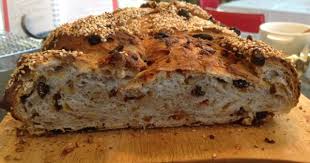
Apricot Raisin bread
straight dough method: add all the ingredient in a dough mixer with cold water. mix 5 mn in a 1st speed and 8 mn 2nd speed. l et rest 30 mn. cut 450gr dough and shape into a round ball. keep rest again for 30-45 mn and shape to desirate form. bake a 220 mn in deck oven foe 30mn
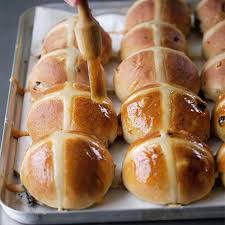
Hot Cross Buns
small quantities of up to 12 dozen buns can be mixed in a 20-quart planetary mixer or small spiral mixer. Stand mixers can mix up to 2 dozen buns. Place the final dough flour in the mixing bowl, add the soft butter, and mix just until the butter is dispersed. Add the eggs, sugar, salt, and allspice and mix them all together. Next, add the sponge. Mix on first speed for about 3 minutes until everything is thoroughly combined. Turn the mixer to second speed and mix for about 3 minutes. Strong gluten is not the goal of this mix, but enough dough develop- ment is necessary so that there is sufficient strength to lift the fruits and butter (combined, these are a considerable weight in the dough). When a moder- ate gluten development has been achieved, add the currants and diced peel. Mix until these are evenly distributed throughout the dough. Desired dough temperature: 26℃ bulk fermentation: 1 hour, with a light fold after 30 minutes. dividing and shaping: If using a 36-part dough divider, weigh off 4 presses weighing 2,7kg each. If dividing by hand, cut the dough into 80gr pieces. Round the pieces well, and place them on sheet pans in an even configuration. Cover the trays of buns with a sheet of plastic to prevent crusting on the surface. final fermentation: About 1 hour at 25℃
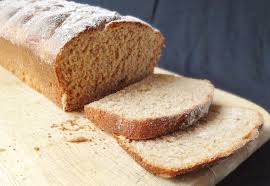
Honey Spelt Flour Bread
Place all the ingredients except the pâte fermentée in a spiral mixer. Mix on first speed for 3 minutes in order to incorporate the ingredients. As the dough is coming together, add the pâte fermentée in chunks. If necessary, correct the hydration by adding water or flour in small amounts. Finish mixing on second speed for 3 minutes. The dough should have good body and supple strength at this point. Mix 30 to 60 seconds longer if the dough seems to lack adequate strength. Desired dough temperature: 24℃ Bulk fermentation: 2 hours. folding: Fold the dough after 1 hour of bulk fermentation. dividing and shaping: Divide the dough into 900gr pieces (or larger, as desired). Preshape into rounds. When sufficiently relaxed, shape into round or oval loaves. Place them either into floured ban- netons or between folds of floured baker’s linen, and cover with plastic. The bread can also be baked in loaf pans or shaped into rolls. final fermentation: About 1 hour at 24℃ Baking: Place the risen loaves on the loading conveyor or peel. Slash as desired. Presteam the oven, load the bread, and steam again. Bake in a 450°F oven, opening the vents once the bread shows color, in or- der to finish the bake in a drying oven. Round loaves scaled at 900gr will bake in approximately 38 minutes. The honey contributes color to the bread, so if the loaves are darkening too quickly, lower the oven temperature by 220℃
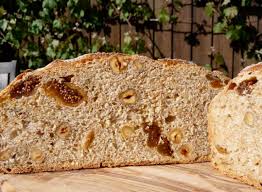
Hazelnut & Fig Bread
mixing: Add all the ingredients except the hazel- nuts and figs to the mixing bowl; the fennel seeds and rosemary can go in at the outset. In a spiral mixer, mix on first speed for 3 minutes in order to incorporate the ingredients thoroughly. The dough consistency should be moderately loose. Turn the mixer to second speed and mix for about 3 minutes more, until a moderately strong gluten development has been achieved. Add the hazelnuts and figs (ei- ther chop the figs or leave them whole, but in either case remove the hard nub of the stem before adding them to the dough), and mix on first speed just until the nuts and figs are thoroughly incorporated. Desired dough temperature: 24℃ bulk fermentation: 2 hours. 3. foldding: Fold the dough once, after 1 hour. 4. dividing and shaping: Divide the dough into 450-900gr pieces (or make rolls of about 80gr). Preshape lightly into rounds and place on a lightly floured work surface, seams up. Cover the rounds with plastic. When the dough has relaxed sufficiently, shape it into tight round or oval loaves. Place the loaves in floured bannetons and cover with baker’s linen and plastic. fInal fermentation: 1 to 11⁄2 hours at 24℃ Baking: With normal steam, 250℃. The figs will contribute a lot to the bread coloring, particularly if they have been chopped; therefore, lower the temperature by about 0℃ after 20 minutes. Loaves weighing 900gr will bake in about 40 minutes, with round loaves taking slightly longer than oval ones.
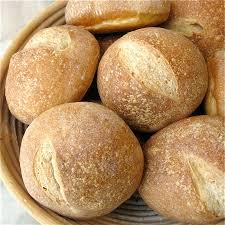
Hard Rolls
soften the yeast in a little water. Fresh yeast: mix with about 2 times its weight in water, or more. Ideal water temperature: 38 ° C Active dry yeast: Mix with approximately 4 times its weight in water. Ideal water temperature: 40 ° C Mix the remaining ingredients, including the rest of the water, in the mixturebowl. Add the dissolved yeast, taking care not to let it come in contact with the salt. Mix with a smooth and developed dough.

Gressini
mixing: For large-scale production of grissini (50 dozen or more), a full-sized spiral mixer can be used. For smaller quantities (3 to 24 dozen), a small spi- ral mixer or 20- to 30-quart planetary mixer works well. Place all the ingredients in the mixing bowl. In a planetary-style mixer, mix on first speed until the ingredients are incorporated, about 3 minutes. The dough should be of medium consistency. Turn the mixer to second speed and mix for another 4 or 5 minutes, to a moderate gluten development. Desired dough temperature: 24℃ bulk fermentation: 1 hour. dividing and shaping: If using a 36-part dough divider, divide the dough into 2 pieces weighing 1.36 kg each. If scaling the bread sticks indi- vidually, divide the dough into portions. Let the divided pieces rest on a lightly floured work surface, covered with plastic, for about 10 to 15 min- utes. Roll or stretch the pieces, trying to keep an even dimension along the length, to 15to 25 cm long. Before transferring to baking sheets, the individual bread sticks can be rolled in a tray of fine semolina if desired; this adds a bit of texture to the taste. An alternative means of dividing the dough is to press it into a flat rectangle on a floured bench and cut it into thin strips with a pizza wheel. BaKing: By the time the bread sticks have been divided, they can be baked right away with no fur- ther proofing. Bake at 180℃ for about 20 minutes, or until golden brown. Once cool, the bread sticks can be stored in airtight containers for up to 5 days.
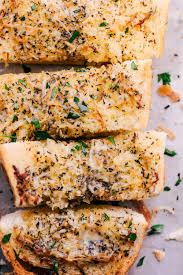
Garlic Bread
roated the garlic in over for 45mn at 160℃ mixing: Add all the ingredients to the mixing bowl, including the garlic. In a spiral mixer, mix on first speed for 3 minutes, adjusting the hydration as necessary to achieve a dough of medium consistency. Mix on second speed for approximately 3 minutes more, to a moderate gluten development. Desired dough temperature: 24℃ bulk fermentation: 1 to 2 hours. folding: If the bulk fermentation lasts 2 hours, fold after 1 hour. No folds are needed if the dough ferments only 1 hour. dividing and shaping: Divide the dough into 450-900gr pieces; shape round or oval. Tasty rolls can be made as well. final fermenTaTion: 1 to 11⁄2 hours at 24℃ baking: With normal steam, 250℃ for 40 to 45 minutes
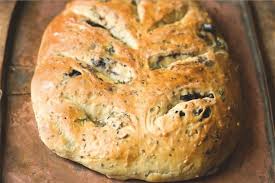
Fougasse
mixing: Add all the ingredients to the mixing bowl except the pâte fermentée, the olives, and the olive oil. For production of 20 pounds of fougasses or fewer, a small spiral mixer or 20-quart planetary mixer works well. In a planetary-type mixer, mix on first speed for 3 minutes in order to incorporate the ingredients. As the dough is coming together, add the pâte fermentée in chunks. If necessary, correct the hydration by adding water or flour in small amounts. The dough should be of medium consistency at this point. Turn the mixer to second speed and begin drizzling in the olive oil. Mix on second speed for 5 to 6 minutes until the dough has moderate gluten development. Add the pitted olives and mix on first speed just until they are evenly incorporated. In a planetary mixer, as opposed to a spiral mixer, it is a more dif- ficult and lengthy process to add ingredients at theend of a mix, such as the olives in the present case. If it takes too long to incorporate them, the olives will break apart and the dough will take on an unpleasant purplish hue. Here is a technique that can help: Once the dough has been fully mixed and it is time to add the olives, pull the dough away from the hook, creating an opening in the center of the dough. Pour about one-third of the olives into this opening, then turn on the mixer. The olives, rather than just smearing around the outside of the bowl, will be incorporated from the inside outward. After 20 or 30 seconds, turn off the mixer and again pull the dough away from the hook, creating another opening. Pour half the remaining olives into the opening and turn the mixer on once more. Do this a third time, add- ing the remaining olives, and mix until the olives have been evenly mixed into the dough. The desired dough temperature is 24℃ bulk fermentation: 2 hours. folding: Fold the dough once, after 1 hour ofbulk fermentation. dividing and shaping: Divide the dough into 450gr pieces. Round lightly, place on a floured work surface with the seams down. plastic. Let the dough relax for about 20 minutes. When sufficiently relaxed, use a rolling pin to flatten the dough into an oval shape. final fermentation: About 1 hour at 24℃ baking: When the fougasse has risen, the final shaping occurs. Pick up the dough and stretch it gen- tly so that it is about half again as long as it was. Now, shape it into a long triangle with a base about half the length of the height. Next, using a pizza wheel or a paring knife, cut several diagonal slices into the dough, as in illustration A at left. Now stretch the dough some more, so the cuts open, as in illustra- tion B. Transfer the fougasse to a loading conveyor
